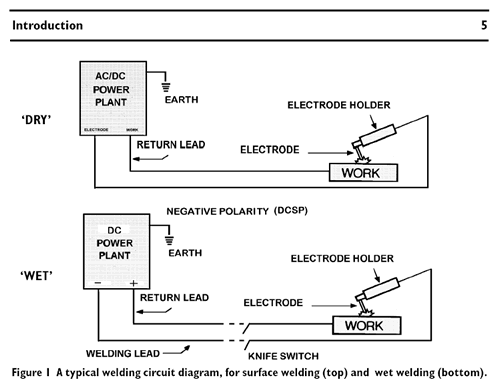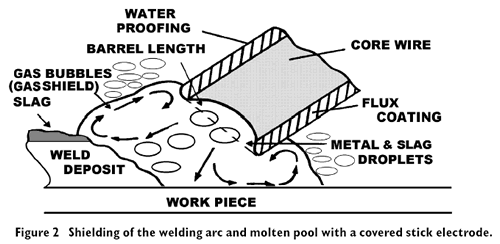Preview2
Discover why Operation
is different Underwater
Introduction
Preview2: This is the second extract from the proposed book.
We are glad and proud of having been authorized by the Author
of the very important Book on Underwater Wet Welding, titled
"A Welder's Mate"
David J. Keats
Dip.Eng., L.Eng., Sen.M.Weld.I
International Welding Technologist / Senior Welding Inspector
of Speciality Welds Ltd.,
to publish here, in the Welding Advisers Website, Preview2, a second extract from
Underwater Wet Welding - A Welder's Mate
Principles of Operation
Manual metal arc welding (MMA) is still one of the most important fusion welding processes, for both surface and underwater welding in today’s construction industries. American terminology refers to it as Shielded Metal Arc Welding (SMAW).
The definition of fusion welding, as stated in BS 499: Pt 1 1991 states, "any welding process in which the weld is made between surfaces brought together to a molten state, without hammering or pressure". Any arc-welding system in which the electrode is melted off to become part of the weld is described as metal-arc.
Briefly, the process takes place in the following manner. The work to be welded is connected to one side of an electric circuit, via means of a cable. A flux-coated electrode is attached to a holder, also connected via a cable, both being attached to a power source.
When the electrode makes contact with the work, an electrical contact is made. The electric current jumps the gap and causes a sustained spark (arc), which melts the base metal and the covering of the electrode forming a common weld puddle.

Compare the two diagrams in Figure 1 and you will notice a couple of differences for the wet welding one, namely; DC current only, the use of a knife switch and the double insulated cables. The polarity, which is generally DCSP (-), although can also work quite satisfactorily on DCRP (+), otherwise, the basic circuit is the same.
After the arc is moved or discontinued, the metal solidifies so the previously melted metal has now fused into one piece. This melting action is controlled by varying the amount of electric current which flows across the arc, and by changing the size of the electrode. Typical temperatures that exist within the arc plasma can reach over 5000ºC.
As the electrode melts, metal droplets are projected into the weldpool. This common pool of molten metal is called a puddle. This puddle solidifies behind the electrode as it is moved along the joint being welded. The result is a fusion bond and the metallurgical unification of the workpieces.
Now, metals at high temperature are active chemically with the main constituents of air, oxygen and nitrogen. Should the metal in the molten puddle come in contact with air, oxides and nitrites (instant rust) would be formed, which upon solidification of the molten pool would destroy the mechanical properties of the weld joint.
For this reason, the various arc-welding processes provide some means for shielding the arc and the molten puddle with a protective shield of gas, vapour and slag. This is referred to, as metallic arc shielding, and such shielding in MMA welding is accomplished by the flux covering of the electrode.
The slag even after the weld has solidified still has a protective function, as it minimises contact of the very hot metal from the air, until the temperature lowers to a point where any reaction of the metal with air is eliminated.
The arc itself burns in a small cavity formed inside the flux covering, which is designed to burn slower than the metal barrel of the electrode, thereby, assisting in protecting and controlling the metal droplets that leave the electrode.
This barrel is called the cup or barrel length. For wet welding this particular function is very important, for without this mechanism the production of acceptable weld deposition would be difficult, as it greatly assists a constant and controlled arc length to be maintained.
Therefore, even in poor visibility, all the diver need do is exert a slight downward pressure on the electrode to maintain a constant feed rate, which keeps the flux chipping and burning away without the need for any arc length control, as such.
Now, for underwater welding the arc does not behave as in air. The activity of the gas bubbles being particularly important, as this tends to create a rather unstable arc condition, compared with surface welding, together with a somewhat more confusing weld puddle, which must be mastered by the diver before successful welding can take place.
Apart from this, with regard to the actual physical principles of operation, there is no difference between surface MMA welding and underwater wet-stick welding. Both processes use basically the same equipment with the exception of necessary waterproofing for the electrodes and certain other safety equipment.

The electrodes themselves may be either carbon manganese (C/Mn) or mild steel if you prefer, and stainless steel (duplex). With the rutile mild steel electrodes being the most widely used, but more about electrodes later.
* * *
Any questions or comments or feedback? Write them down and send them to us by e-mail.
Click on the Contact Us button in the NavBar at top left of every page.
Top
Note:
Welding Advisers hopes you enjoyed reading Preview2,
the second extract from the Book.
To order the book online click on A Welder's Mate.
To see the previous book extract click on A Case for Wet Welding.
To see the following book extract click on Basic Techniques.